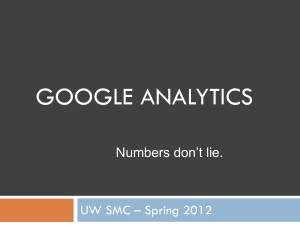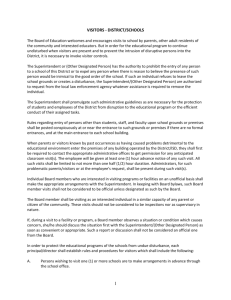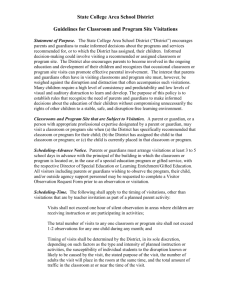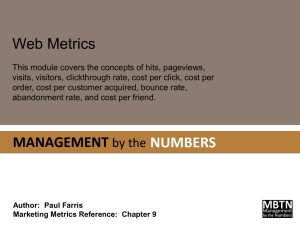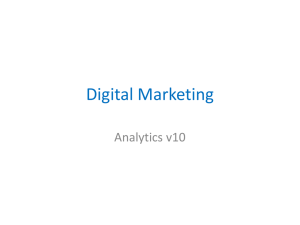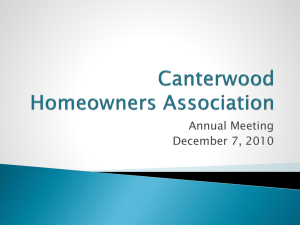Page A - Webtrends Training (EMEA)
advertisement
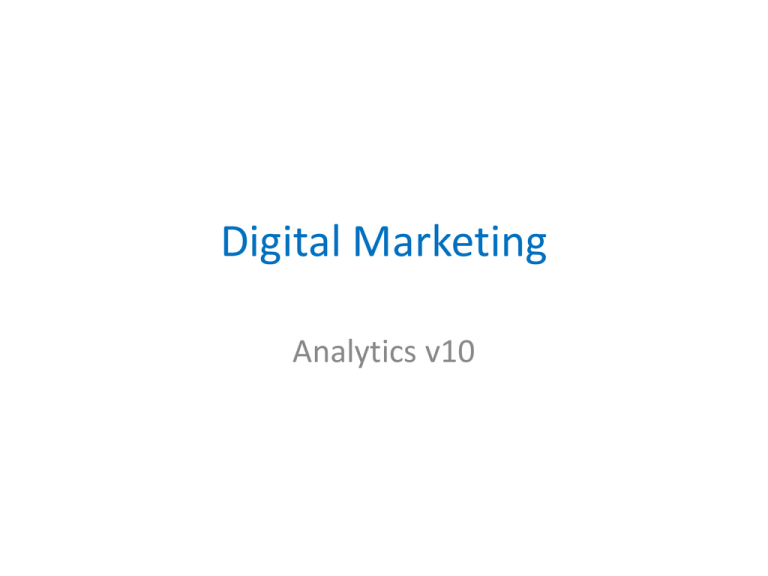
Digital Marketing Analytics v10 Introduction Name / job role What company are you with How much experience do you have using Webtrends Create a Word document for your notes .. Agenda Digital Marketing Overview Web Analytics Web Analytics When implementing web analytics for the first time, you will want to gain insight into the initial visitor metrics: (Benchmarking) How many daily visitors you receive Your average conversion rate (sales, registration, download, etc.) Top visited pages The average visit time on site and how often visitors come back The average visit page depth and how this varies by referrer The geographic distribution of visitors and what language setting they are using Web Analytics Web Analytics Digital Marketing Terminology Terminology Hit - A hit is any request to a web server. Each time a visitor downloads a page, clicks a hyperlink, views a graphic, or performs any other action on a web site, a call is made to the web server. The web server records each of these requests in a log file. These requests are commonly known as "hits," and the loading of a single web page can amount to many hits, due to all of the elements it contains. Page View - A page view represents a hit to any file designated among the page file types. The most common examples are files ending in .html, .htm, .php, .asp, or .aspx. Defined when WT.dl=0 Terminology Webtrends parameter (WT.dl) You should use this method if you use Webtrends On Demand or SmartSource Data Collector (SDC) with the Webtrends tag. This method identifies a hit as a page view whenever the wt.dl parameter is present in the server call and has a value of zero (0). Terminology Visit - A visit is a session of continuous activity where all hits are recorded in the log file for one visitor to a web site. The visit starts the moment of the first hit on the web site and continues until the session ends: - 30 minute period of inactivity (default) - the visit ‘crosses’ a reporting time period Active Visit – An ‘open’ visit count that occurs in a defined time period. Terminology Webtrends OnDemand aggregates the visitor data to five standard time periods: Time Frame Daily Weekly Monthly Quarterly Yearly Terminology Webtrends OnDemand aggregates the visitor data to five standard time periods: Monday Tuesday Wed Thursday Friday Saturday Sunday Visits 3 Visits 3 Visits 1 Visits 3 Visits 2 Visits 3 Visits 2 Visitors 3 Visitors 2 Visitors 1 Visitors 3 Visitors 2 Visitors 2 Visitors 2 Terminology Unique Visitor / Unique User - The uniquely identified client generating requests on the web server (log analysis) or viewing pages (page tagging) within a defined time period (i.e. day, week or month). A Unique Visitor counts once within the timescale. A visitor can make multiple visits. Identification is made to the visitor's computer, not the person, usually via cookie and/or IP+User Agent. Thus the same person visiting from two different computers will count as two Unique Visitors. Terminology New Visitor - A visitor that has not made any previous visits. This definition creates a certain amount of confusion (see common confusions below), and is sometimes substituted with analysis of first visits. Returning Visitor - A visitor that has made at least one previous visit. The period between the last and current visit is called visitor recency and is measured in days. Visitors not accepting Cookies - A visitor that cant be tracked due to browsers not accepting JavaScript. Terminology Terminology Bounce Rate To understand the difference between exit and bounce rates for a particular page in your site, keep in mind three things: For all sessions that start with the page, bounce rate is the percentage that were the only one of the session. For all page views to the page, the exit rate is the percentage that were the last in the session. The bounce rate calculation for a page is based only on visits that start with that page. Terminology Let's clarify this last point with a simple example. Your site has pages A to C, and only one visit per day exists, with the following page view order: Monday Tuesday Wednesday Page A Page B Page A Page B Page A Visit finished Page C Page C Page A: 3 page views 50% Bounce Rate Page B: 2 page views 0% Bounce Rate Page C: 2 page views 0% Bounce Rate BR = Single Page Visits * 100 Entry Page Visits Digital Marketing Summary Summary
